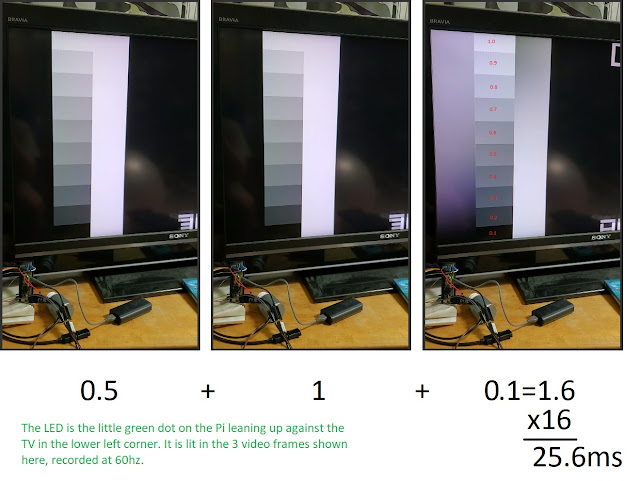GPX TDE3245W review: input lag and upscaling tested using the piLagTesterPRO
This 720p TV from 2016 is rather mediocre, with variable input lag, aliasing, and in general very little to recommend it for gaming, retro or otherwise. It does have one very unusual "feature", however: it redraws from the bottom of the display to the top.
Overview/Image quality
 |
| 1 pixel wide checkerboard |
It has all the standard inputs, including 3 HDMI, VGA, and 2 yPbPr; I only tested HDMI.
Input Lag
This display does not have a game mode; not even a game 'color' preset. It does offer noise reduction and dynamic contrast, both of which I turned off, though it didn't seem to change the speed of the display at all.
I used a piLagTesterPRO to measure input lag. This device sends a frame of video over HDMI and measures how long it takes to display it. Complicating things significantly, this TV is yet another display that does not actually sync to the input signal - instead it fills its own internal frame buffer from the video input and then draws that with a fixed additional delay of up to 16ms, randomly determined each time you turn on the set or switch inputs. At least it can actually draw at 60hz or 59.94hz so whatever lag you get when you turn on your console will be constant for that session, with no dropped frames. It can also draw at 50hz and 24hz, the later of which is particularly nice for watching movies.
Because lag varies each time it is turned on, I've elected to report the average lag values here, since that seems fairest, but there's no right answer; for more discussion of this issue see the above link.
The truly surprising thing about this set is that it draws from the bottom of the screen to the top, something I've never seen before. Yes, the lag is lowest at the bottom, and gets longer and longer as you move up the screen. I can think of no plausible advantage to this. The signal sent over HDMI (and all other cables) starts at the upper left corner and scans down, so this means that the TV has to wait until the entire frame has been sent before it can start doing any processing or preparation for drawing it. From that perspective it's impressive that the input lag I measured isn't much, much worse.
This raises the question of how to report the results - with the top being the slowest to respond to a frame of video it's going to unfairly penalize the results compared to other sets where the top is the first to respond. So in all cases I flipped the labels so that "top" means where drawing starts, and bottom means where drawing ends, like on a regular display.
Full Test Results
I report two kinds of values. 1st response measures how long it takes for the TV to start responding (I use a 5% change in display brightness). This overly optimistic value doesn't tell how long it takes to see anything useful, but matches what other reviewers call input lag. full response is a more realistic measure of lag, and requires the display to reach 80% of full brightness. This combines both input lag and response time, and is closer to what you would actually experience in a game.Results compared to other displays
If it weren't for the variable lag this TV would be pretty decent, since recall that on a good day it can start to respond after only 20ms , mildly better than many TVs listed here. But the average lag is more representative, and once you add in the response time this TV is on the slow end of average at best. The 480i results are some of the worst I've seen, too.
Conclusion
Other models (to avoid)
I suspect GPX is the actual manufacturer of this set. But comparing it's motherboard to other TVs, it's pretty clear that a lot of other manufactures sold this or something very similar to it under their own name. Now, it's always possible that with different firmware the input lag or deinterlacing speeds would differ, but until somebody else tests these models and finds different, you can assume the same lackluster performance from these sets:
Apex LE3245M
Polaroid 32GSR3000FC
Polaroid 32GSD3000FA
Westinghouse DWM50F3G1
Element ELEFW328B
Element ELEFW408
Element ELST4316S (maybe, it has smart TV features unlike this GPX model)
Proscan Plded3996a
Proscan PLDED3280A-D
Seiki SE32HY10
Axess TVD1801-32
Sansui SLED5515W
To repeat: I only tested the GPX TDE3245W. But all of the above have nearly identical motherboards and on-screen menus. Some of them come in different sizes than the model listed, too, so this single review may have resulted in measuring 15 or more displays. I'd be very curious if anybody can confirm or deny this assertion. One simple test would be to photograph the screen with a high-speed (ish) camera and see if it's indeed painting from the bottom to the top.



Comments